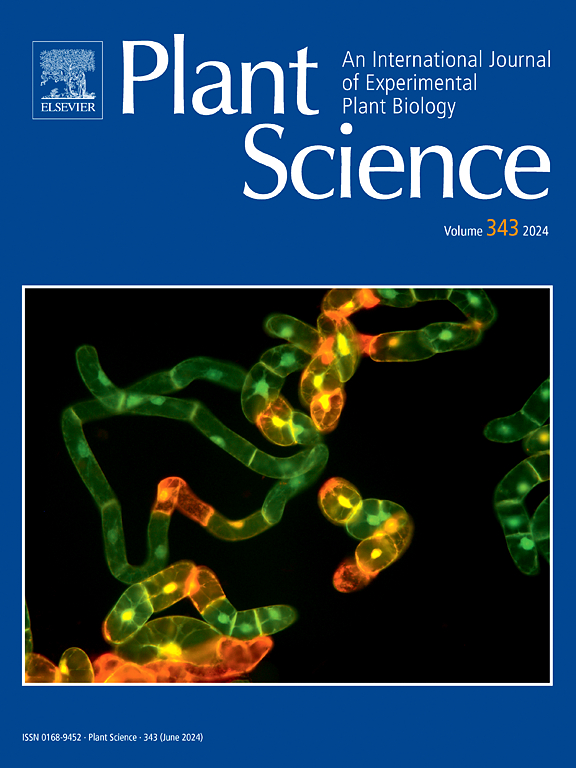Putrescine attenuates heat stress by modulating membrane stability, antioxidant activity, and gaseous exchange in Brassica juncea L.
IF 4.2
2区 生物学
Q2 BIOCHEMISTRY & MOLECULAR BIOLOGY
引用次数: 0
Abstract
Rising temperatures severely stress plant growth and development by disrupting metabolic processes. Indian mustard (Brassica juncea L.) faces extreme temperatures during various growth phases. Early-sown Brassica encounter heat stress during germination and vegetative phases, while late-sown suffer higher yield losses due to increased evaporative demand during the reproductive stage, leading to faster maturation, increased senescence, and reduced productivity. Polyamines (PAs), small positively charged nitrogenous compounds, play important roles in plant growth and stress responses. Putrescine (Put), a key PA, is known to enhance plant growth and provide tolerance from stresses. This research aimed to explore how Put (1 mM) mitigates heat stress effects on early, timely, and late-sown genotypes RH-1707, RH-1708 (heat-sensitive), and RH-1566 and RH-1999–42 (heat-tolerant). RH-1999–42 showed the highest tolerance under early heat stress, while RH-1708 was the most sensitive. Conversely, RH-1707 experienced significant losses under late heat stress, whereas RH-1566 displayed tolerance under both early and late heat stress.Exogenous application of Put alleviated heat stress by reducing lipid peroxidation, hydrogen peroxide, electrolyte leakage, transpiration rate, stomatal conductance, and stomatal density, while boosting antioxidant enzyme activities, chlorophyll content, relative water content, proline content and overall yield. The most significant benefits were observed in RH-1707 and RH-1708, which were higher susceptible to cellular damage under heat stress. Anatomical examinations revealed enlarged xylem vessels in RH-1707 and RH-1708 under early sowing, while late-sown plants showed less developed vessels. Put application partially reduced vessel size under early heat stress, though its effects were minimal during late heat stress. This study demonstrated that 1 mM Put foliar spray effectively mitigates the harmful effects of heat stress at early and late-sown stages in Brassica juncea L.
腐胺通过调节芥菜膜稳定性、抗氧化活性和气体交换来减弱热应激。
气温升高扰乱了植物的代谢过程,严重影响了植物的生长发育。印度芥菜(Brassica juncea L.)在不同的生长阶段面临极端的温度。早播芸苔在发芽和营养阶段遭受热胁迫,而晚播芸苔在繁殖阶段由于蒸发需求增加而遭受更高的产量损失,导致成熟更快,衰老加剧,生产力下降。多胺(Polyamines, PAs)是一种带正电荷的小氮化合物,在植物生长和逆境响应中起着重要作用。腐胺(Put)是一种关键的PA,已知可以促进植物生长并提供对胁迫的耐受性。本研究旨在探讨Put(1 mM)如何减轻早播、适时播和晚播基因型RH-1707、RH-1708(热敏型)、RH-1566和RH-1999-42(耐热型)的热胁迫效应。RH-1999-42对早期热胁迫的耐受性最高,RH-1708对早期热胁迫最敏感。相反,RH-1707在后期热胁迫下损失显著,而RH-1566在早期和晚期热胁迫下均表现出耐受性。外源施放通过降低脂质过氧化、过氧化氢、电解质泄漏、蒸腾速率、气孔导度和气孔密度来缓解热应激,同时提高抗氧化酶活性、叶绿素含量、相对含水量、脯氨酸含量和总产量。在RH-1707和RH-1708中观察到最显著的益处,它们在热应激下更容易受到细胞损伤。解剖检查显示,早播的RH-1707和晚播的RH-1708木质部血管增大,晚播的木质部血管发育较弱。在早期热应激条件下,涂敷剂部分减小了血管尺寸,但在后期热应激条件下效果最小。本研究表明,1 mM Put叶面喷施能有效缓解芥菜播前期和播后期热胁迫的危害。
本文章由计算机程序翻译,如有差异,请以英文原文为准。
求助全文
约1分钟内获得全文
求助全文
来源期刊

Plant Science
生物-生化与分子生物学
CiteScore
9.10
自引率
1.90%
发文量
322
审稿时长
33 days
期刊介绍:
Plant Science will publish in the minimum of time, research manuscripts as well as commissioned reviews and commentaries recommended by its referees in all areas of experimental plant biology with emphasis in the broad areas of genomics, proteomics, biochemistry (including enzymology), physiology, cell biology, development, genetics, functional plant breeding, systems biology and the interaction of plants with the environment.
Manuscripts for full consideration should be written concisely and essentially as a final report. The main criterion for publication is that the manuscript must contain original and significant insights that lead to a better understanding of fundamental plant biology. Papers centering on plant cell culture should be of interest to a wide audience and methods employed result in a substantial improvement over existing established techniques and approaches. Methods papers are welcome only when the technique(s) described is novel or provides a major advancement of established protocols.
 求助内容:
求助内容: 应助结果提醒方式:
应助结果提醒方式:


